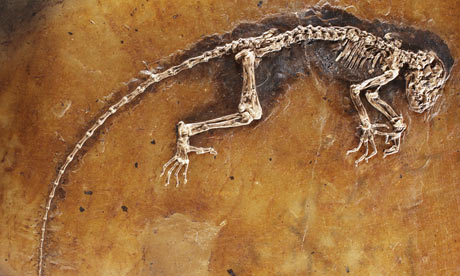 Fossil Ida's great big family
Fossil Ida's great big family
(Colin Tudge, The Guardian, 19 May 2009)
Ida is a truly extraordinary find. The 47 million-year-old remains of a plausible human ancestor, with structural details still intact, can teach us an enormous amount. But what I really like about her is what she tells us about evolution in general, and " in this year of his bicentenary " what she tells us about Charles Darwin; and what she can tell us about our attitudes to nature and our own survival on this Earth. So many years after her death, this humble creature could help to restore a little sanity in a world that seems to have run short of it.
Yet she is not the kind of ancestor most modern evolutionary biologists would have been looking for. She is the right general kind of creature " very clearly a primate, as we are. But modern primates are divided into two main groups: the lemurs and bush babies on the one hand, and the monkeys and apes on the other. Zoologically speaking, human beings belong firmly among the monkeys and apes. The first primates probably appeared about 70m years ago. The lemur lineage and the monkey-ape-human lineage are thought to have separated soon after the dinosaurs disappeared, probably about 60m years ago. The two groups still have much in common, but after all that time there are significant differences.
Ida has much in common with lemurs and so " surely " she is ruled out of our own dynasty. But she also shares many features with monkeys. In other words she could be close to the common ancestry of both groups. The monkey-ape-human group and the lemur group may not be so very distant after all.
The discovery of the beautiful fossil primate Ida is a triumphant vindication of the greatest of Darwin's insights " but not, alas, the one for which he is best remembered: natural selection. Selection, the mechanism he proposed as the driving force of evolution, is of course important " it is one of the most important insights of modern humanity, with implications that extend far beyond the living world.
But the concept of natural selection, and Darwin's own presentation of it, has one very unfortunate aspect. For it is rooted in the idea of competition. All creatures are perceived to be locked in mortal combat from the time they are conceived until they finally lose the battle, either with each other or with their own inevitable decay.
Indeed, Darwin's Origin of Species by Means of Natural Selection, published in 1859, seemed to vindicate Tennyson's adage from 20 years earlier, of "nature red in tooth and claw". Herbert Spencer, in the decade after Darwin, summarised natural selection as "survival of the fittest" " a slogan Darwin only later adopted.
Now we have a global economy based on to-the-death competition and strong-bashes-weak, and various intellectuals make a living telling tycoons and politicians that this is a good thing because it is the "natural" way of the world. Of course what is natural is not necessarily good, but Darwin's notions are taken nonetheless as a bedrock justification for universal viciousness. Darwin was a humanitarian, and in some ways deeply religious, so this, surely, is not what he would have wanted.
But Darwin's conception of evolution had another thread to it " altogether more cheerful, but nowadays less prominent. For he also suggested that if evolution is a fact then " whether or not natural selection is the principal mechanism " all creatures might trace their ancestry back until they find that they derived from the same common ancestor.
In other words, all creatures now on Earth are literally related, one to another. We are closest to African apes, but only slightly less distanced from monkeys, and slightly further from lemurs. But we are also related, albeit more and more distantly, to mice and fish and beetles and mushrooms and oak trees and so on, outwards to the humblest bacterium.
Some people find this idea distasteful. Many don't want to be related to chimps, let alone snails. Some religious people find it blasphemous. But many do not. St Francis, often considered as the saint who was closest in spirit to Christ, spoke of the other animals and plants as his brothers and sisters. It is this that Darwin's idea " and now Ida " truly vindicates.
In this vision, Ida sits at the cusp. Miraculously preserved though she is, she may look to the untrained eye like a roadkill squirrel, and she belongs to a time " 47m years ago " too remote to contemplate. Yet the details of her skeleton proclaim her human affinity. She is indeed a "link", not only with our own ancestors but with all the rest of the living world " indeed to all the creatures that have ever lived on this Earth.
These days lip service is paid to the idea of conservation. "Biodiversity" is dimly supposed to be a good thing because it represents a "resource". It is also thought that some creatures and ecosystems are proving more useful than suspected " like tropical forest, which moderates the world's climate.
At best, though, other species impinge on conventional politics only insofar as they are commodities. What isn't useful is irrelevant, or even a "pest", to be destroyed at all costs. Perhaps if we once admit in Franciscan and Darwinian vein that the creatures we so insouciantly brush aside are our relatives, we would treat them differently. And that would be good for every living creature on this planet.